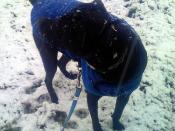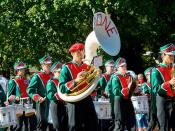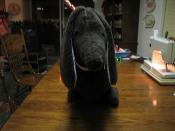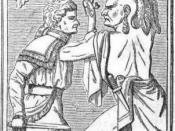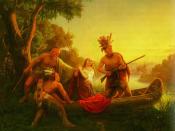Boone Caudill: An Admirable Mountain Man A.B. Guthrie Jr.'s novel, The Big Sky, accurately portrays the life and overall personality of a mountain man of the early 19th century through its story of Boone Caudill. Boone has numerous negative characteristics which were probably typical of mountain men of the west, such as his quick, often violent, temper and act first think later mentality,. Despite these negative characteristics, Boone is ultimately an admirable man because of the many positive traits such as loyalty to his companions and his brave and heroic attitude, which he displays throughout this novel .
The typical view of a mountain man is a rough, violent, quick-tempered solemn adventurer, and Boone Caudill was no exception to these stereotypes. One of Boone's less admirable characteristics was his attitude toward most women. He used many squaws for physical pleasure without any emotional attachment to them. This however was not an uncommon practice by mountain men, and the squaws or their fathers often prostituted them to obtain desired goods, such as horses, clothes, guns etc.
But Boone's horrible treatment of women is most apparent on page 357, when he leads a girl named Nancy to believe that the two of them will be married, but uses her for sex and then leaves her sobbing, telling her "I got a woman."ÃÂ It is clear that Boone either does not care about women's emotions, or he is unaware that he is hurting them, either way it is one of his negative traits.
Perhaps the most severe of Boone Caudill's negative characteristics was his quick and violent temper, which lead him to act first and think later. The event that shows Boone's temper and violence most, occurs near the end of the book, on page 322. Boone suspects that his best friend Jim Deakins is sleeping with his wife Teal Eye. Overwhelmed by suspicion and anger at the possibility that Jim and Teal Eye had been together prompts Boone to spy on the two when they are alone together. After hearing Jim comforting a crying Teal Eye, Boone bursts into the tepee where they are holding each other in their arms. Seeing the two of them hugging each other enrages Boone and without thinking he shoots his best friend Jim in the chest killing him. "They fell apart, and Jim said, "Boone!"àand didn't say more but stood trying to smile and the firelight showing guilt on his face"æ The pistol was better than the rifle. Jim cried "Boone! Boone!"ÃÂ"æ The pistol sounded big. Jim staggered back, feeling as if his whole chest was empty (323)."àBoone's temper causes him to kill his best friend in the world, Jim Deakins, without any evidence showing that Jim was guilty, and in fact Jim was innocent. Boone's quick, violent temper is by far his most negative characteristic.
In addition to these negative characteristics, Boone also had positive traits that made him a likable person. He was a brave and heroic mountain man who fought with Indians and risked his life to protect his friends. Boone was extremely loyal to his friends, and didn't hesitate to put his life on the line for them. In one situation Jim is shot by an Indian and seriously wounded. He can't walk and is barley concious. Jim tells Boone to leave him and escape, before the two are trapped in the mountains by snow. Boone could have easily left Jim to die, and save himself, but instead he stays with Jim through the whole winter and nurses him back to health. During this time Boone faces near starvation, but insists on giving the small portion of meat that they have to Jim. Even though he endures unimaginable hardships during the winter, Boone does not once regret staying with Jim. The sacrifice that Boone makes for Jim is a true testament to Boone's great loyalty to his friends.
Weighing both the positives and negatives of Boone, his loyalty wins out over his quick temper, ultimately making Boone an admirable figure. One must remember that Boone did not come from the best background. His father was a violent alcoholic who beat Boone often. Boone had no role model to teach him what was right or wrong. He had to learn those lessons for himself, and thus his temper and violent nature developed as a result of poor upbringing and the wild wilderness that made violence almost a necessity to survive. As a mountain man violence presented itself often, whether it be drunken skirmishes with other mountain men, or fending off attacking Indians. Boone also needed to be violent in order to survive life in the wild mountains. In one particular event the ship that Boone and some of his fellow companions are on is attacked by Indians. The Indians kill almost all the men, but Boone fights fiercely and escapes with his life. At another time Boone is attacked by a single Indian who wants his scalp. He had to fight violently and kill the Indian so as to save his own life. Boone's temper and violent nature are understandable, because the wild, untamed wilderness of the mountains forced a man to be violent to survive. Boone is admirable, because he is a good person, as his loyalty outweighs his understandable temper and necessary violent nature.
Another aspect of Boone that makes him admirable, which is subtler than his loyalty, was the fact that Boone was able to survive the dangerous and often deadly profession of being a mountain man. The end of the road for most mountain men, was not in a rocking chair watching the sun go down in old age, but gruesome death. Dick Summers tells about the many friends that had perished over the years in the mountains. "These were Summers' friends, the best he had in the world, now that the bones of older ones lay scattered from Spanish territory north to British holdings. There was Dave Jackson, who started for California and never was heard from again, and old Hugh Glass, put under by the Rees on the Yellowstone, and Jed Smith, who prayed to God and trusted to his rifle but died young for all of that, and Henry Vanderburgh, a sure-enough man if green, who lost his hair to the Blackfeet, and Andrew Henry, the stout old-timer, who had died in his bed back in Washington County; there were these and more, and they were all gone now, dead or vanished from sight (202)."ÃÂ Whatever the secret skills to survival were, Boone possessed them. Whether it was his accurate shooting, bravery, loyalty, intelligent decision making, hardiness, or his ability to smell trouble coming, Boone was able to survive in the mountains, where many others perished. For this accomplishment Boone deserves to be looked upon as an admirable man.
In addition to accurately depicting a mountain man Guthrie is successful in capturing many facts of the early westward movement. Guthrie shows how, as more white settlers entered the west they changed the land and over-hunted game. Zeb, a mountian man, describes the change to the land that has occurred as the west becomes more settled. "Forts all up and down the river, and folk everywhere a man might think to lay a trap"æ God, she was purty onc't. Purty and new, and not a man track, savin Injuns, on the whole scoop of her"æI mind the time beaver was everywhere"æ another five year and there'll be naught but coarse fur, and it goin fast"æ Ahh! The beaver's nigh gone now. Buffler's next. Won't be even a goddam poor bull fifty years ahead. You'll see plows comin' across the plains, and people settin' out to farm (144)."ÃÂ. As Zeb said the land was once pretty and new, and it had more than enough beaver for everyone, but near the end of the book beaver becomes very scarce and there are settlers heading to Oregon who want to start up farms and settle there. Even though Guthrie does a fantastic job of capturing the untamed wilderness of the west, at the same time he accurately shows how the west was becoming tamer as settlers moved in and beaver became scarcer.
Guthrie also does a good job depicting the effect that diseases such as small- pox had on the Indians of the northwest. When Boone and Jim come across an Indian camp that has been ravaged by small-pox the reader gets a horrifying idea of the effects of white diseases on the Indians. "He heard a thin whimpering, like a pup weak and hurt, and followed the sound of it and came to another tepee in which he saw a boy lying. The boy's face was one solid scab. There was a dead squaw inside the lodge and a dead buck to one side, likely the boy's parents"æ While Boone watched, the body stiffened and the scabbed mouth fell open. The lungs let out a long shuddering breath, snatched once at the air and then gave up"æA man couldn't tell one face from another, swollen the way they were and scabbed, and sometimes eaten on. There wasn't one person alive. The boy had been the last (225)."àDisease had a devastating effect on Indians, and through scenes such as this Guthrie captures this fact and accurately portrays it to the reader.
Guthrie also captures the lighter side of mountain man life at rondevous. He accurately depicts the joy and party-like atmosphere of the gathering. From the rondevous the reader gets an idea of the egotistical, confident fun loving person that mountain men were. At the once a year gathering the men exchange exaggerated stories of how accurate a shot they are, and how they can shoot around corners (195). They tell of how they fought and defeated large numbers of Indians single handedly, or how they wrestled grizzly bears. Through this description of rondevous, Guthrie accurately captures the joy of the event and the spirit of the mountain men.
Guthrie does a fantastic job of portraying the personality of a mountain man to the reader. He gives Boone many positive and negative characteristics, but overall portrays him as an admirable figure. By reading the book one gets not only an accurate representation of a mountain man, but the wilderness world in which he lives. Guthrie shows both the negative effects that man had on the west and the Indians living there, but also captures the lighter side of the west at rondevous and the spirit of the mountain men.
